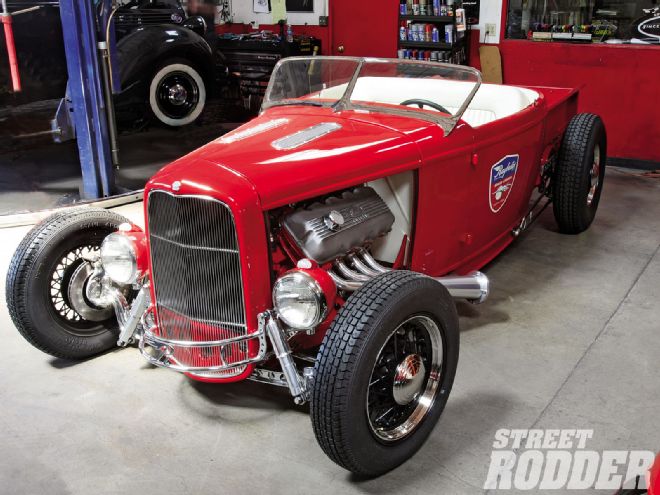
Everywhere you look, there it is-that Jeff Norwell illustration of the highly hot-rodded red '32 Ford open-wheeled roadster pickup with the all-steel body, an engine that looks an awful lot like an injected Ford 427 SOHC race motor, and the familiar Raybestos shield-shaped logo on the doors.
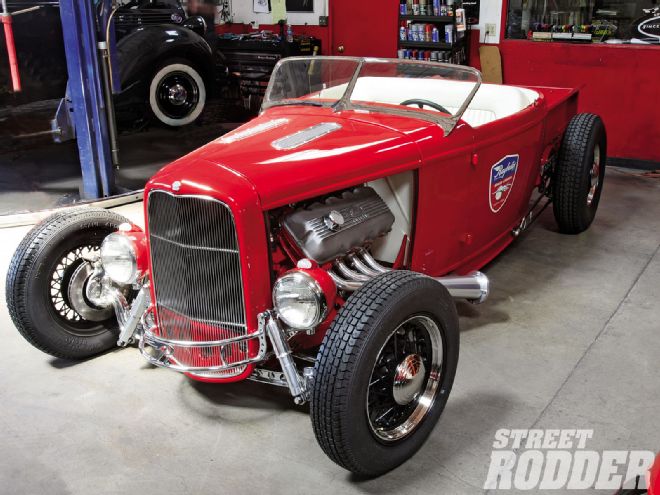
As we reported four months ago, the Raybestos Roadster Pickup is being built by Hollywood Hot Rods (HHR) in Burbank, California, and will eventually be given away in a sweepstakes sponsored by Raybestos.
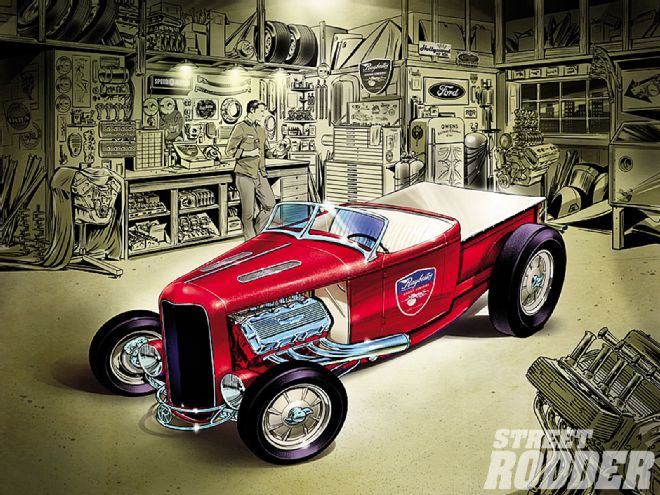
The body is a '32 Brookville rpu repro and the engine isn't a 427 cammer at all, but Ford Racing's brand-new Coyote engine. We'll be taking a closer look at the 32-valve DOHC Coyote in the future-but this one stands alone, due in part to those custom valve covers and lakes pipes, and a Hilborn fuel injection system combining old-timey stacks with an up-to-date electronic engine management system to efficiently feed the 32-valve twin independent variable camshaft timing 5.0 liter.
Contemporary technology disguised in traditional styling is a growing movement in hot rodding and is the signature look of rods rolling out of HHR, where Troy Ladd and his crew keep coming up with cool ways to crossbreed the heritage of the old and the performance advantages of the new. The Coyote engine we just mentioned isn't the only part of the Raybestos rpu to get this treatment. The truly unique suspension, designed and fabricated at HHR, has the appearance of traditional-style front and rear hairpin radius rods, but-as we figured out from the engine-looks can be deceiving. For example, those rear hairpins are really the lower arms of a triangulated four-bar rear suspension.
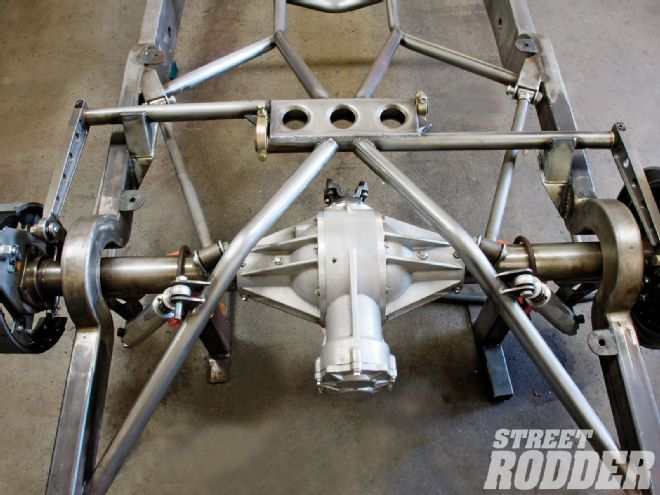 Before the body and bed were dropped onto the frame, we got a good look at the Indy-car-inspired chassis, including the boxed Deuce frame, corner-to-corner tubular crossmembers, Speedway Engineering quick-change rearend, upper four-bars, and rear torsion bar suspension. "Everything is based on an X because the triangles are the strongest shape," Troy from Hollywood Hot Rods explains. "We went nuts with the tubing to make it all extremely sturdy."
Before the body and bed were dropped onto the frame, we got a good look at the Indy-car-inspired chassis, including the boxed Deuce frame, corner-to-corner tubular crossmembers, Speedway Engineering quick-change rearend, upper four-bars, and rear torsion bar suspension. "Everything is based on an X because the triangles are the strongest shape," Troy from Hollywood Hot Rods explains. "We went nuts with the tubing to make it all extremely sturdy."
Thanks to simplicity and performance advantages, parallel four-bars have become a very common rear suspension choice among rodders. The upper bars help maintain pinion angle and control axle rotation, while the lower bars serve to control front to rear motion of the axle. Lateral (side-to-side) motion of the rearend is controlled by a diagonal Panhard bar running from the rearend housing to the frame.
A triangulated four-bar system is similar, but instead of running parallel to the lower arms, the upper arms are mounted at the center of the rearend on either side of the pumpkin and extend at an angle forward and outward to the framerails. The lower arms provide front-to-back control like they do on a parallel setup. The angled design of the upper arms provides the same control as parallel upper arms, in addition to lateral control, centering the rearend without the need for additional support from a Panhard bar. The result is greater stability and a more compact package, which is an especially valuable benefit on small applications like a Deuce roadster pickup.
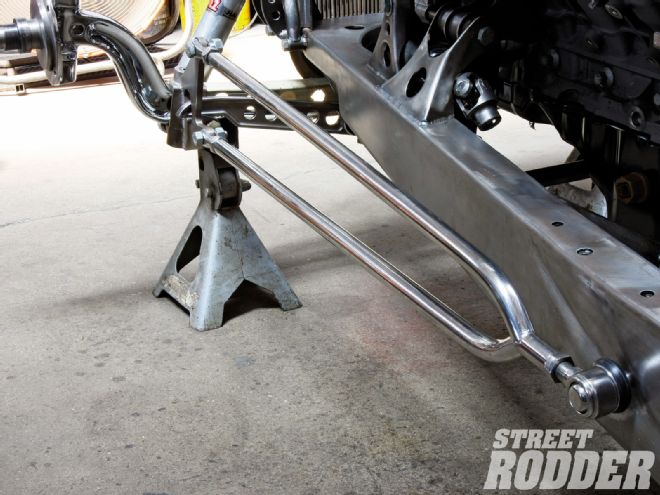 The front hairpins serve as traditional front axle radius rods. HHR notched the front of the frame approximately 1-1/2 inches to drop the roadster. The notch will be out of sight when the body is dropped over it. The left-side trailing arms are visible just rearward of the front axle. More on that later.
The front hairpins serve as traditional front axle radius rods. HHR notched the front of the frame approximately 1-1/2 inches to drop the roadster. The notch will be out of sight when the body is dropped over it. The left-side trailing arms are visible just rearward of the front axle. More on that later.
HHR built a similar "subterfuge" suspension about a year and a half ago on a '32 highboy. On that car, they had used wishbones as the arms, so that the triangulated four-link had the appearance of split 'bones. On the Raybestos rpu, they've taken the concept to another level.
Along with the rear four-bars, they also used front and rear torsion bars-not typically found on hot rods, but more frequently on race cars. HHR has used this type of suspension on a project before, too, when they built Ron Lee's '31 roadster pickup for the La Carrera Panamericana race, adding front and rear torsion bars by Steve Moal at Moal Coachbuilders (for a close look at torsion bar technology, see our coverage of the '31 rpu chassis buildup in the Feb. '09 issue). The advantage of torsion bars, which function as springs, is that they are adjustable for weight changes or handling requirements-a huge plus in race applications.
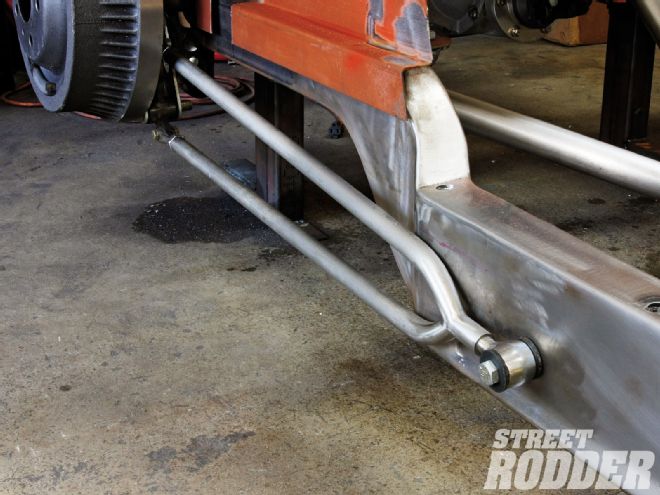 The rear 'rails were kicked up a lot more, with a sweeping Z in the frame where the bed will sit. The bed is positioned so that the bed 'rails will align with the belt line in the body; the wheels where centered in the bed, resulting in a longer wheelbase. The chassis was modified to match.
The rear 'rails were kicked up a lot more, with a sweeping Z in the frame where the bed will sit. The bed is positioned so that the bed 'rails will align with the belt line in the body; the wheels where centered in the bed, resulting in a longer wheelbase. The chassis was modified to match.
You've probably already noticed that the chassis is painted in some of the photos and in bare metal in others. Obviously we made more than one trip to HHR to follow the progress of the chassis buildup. We thought it was helpful to show both earlier shots of the chassis as it was going together and later shots, closer to the final effect.